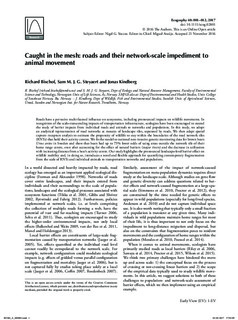| dc.contributor.author | Bischof, Richard | |
| dc.contributor.author | Steyaert, Sam | |
| dc.contributor.author | Kindberg, Jonas | |
| dc.date.accessioned | 2017-09-26T10:15:27Z | |
| dc.date.available | 2017-09-26T10:15:27Z | |
| dc.date.created | 2016-12-14T09:28:03Z | |
| dc.date.issued | 2017 | |
| dc.identifier.issn | 0906-7590 | |
| dc.identifier.uri | http://hdl.handle.net/11250/2456726 | |
| dc.description.abstract | Roads have a pervasive multi-faceted influence on ecosystems, including pronounced impacts on wildlife movements. In recognition of the scale-transcending impacts of transportation infrastructure, ecologists have been encouraged to extend the study of barrier impacts from individual roads and animals to networks and populations. In this study, we adopt an analytical representation of road networks as mosaics of landscape tiles, separated by roads. We then adapt spatial capture-recapture analysis to estimate the propensity of wildlife to stay within the boundaries of the road network tiles (RNTs) that hold their activity centres. We fit the model to national non-invasive genetic monitoring data for brown bears (Ursus arctos) in Sweden and show that bears had up to 73% lower odds of using areas outside the network tile of their home range centre, even after accounting for the effect of natural barriers (major rivers) and the decrease in utilization with increasing distance from a bear’s activity centre. Our study highlights the pronounced landscape-level barrier effect on wildlife mobility and, in doing so, introduces a novel and flexible approach for quantifying contemporary fragmentation from the scale of RNTs and individual animals to transportation networks and populations. non-invasive genetic sampling, road network tile, island biogeography, road ecology, spatial capture-recapture, fragmentation, carnivores, transportation network | nb_NO |
| dc.language.iso | eng | nb_NO |
| dc.rights | Navngivelse 4.0 Internasjonal | * |
| dc.rights.uri | http://creativecommons.org/licenses/by/4.0/deed.no | * |
| dc.title | Caught in the mesh: roads and their network-scale impediment to animal movement | nb_NO |
| dc.type | Journal article | nb_NO |
| dc.type | Peer reviewed | nb_NO |
| dc.description.version | acceptedVersion | nb_NO |
| dc.description.version | publishedVersion | nb_NO |
| dc.source.journal | Ecography | nb_NO |
| dc.identifier.doi | 10.1111/ecog.02801 | |
| dc.identifier.cristin | 1412408 | |
| dc.relation.project | Andre: Polish-Norwegian Research Program | nb_NO |
| dc.relation.project | Norges forskningsråd: 204202 | nb_NO |
| dc.relation.project | Andre: Centre for Advanced Studies at the Norwegian Academy of Scie | nb_NO |
| cristin.unitcode | 7511,2,0,0 | |
| cristin.unitname | Avdeling for terrestrisk økologi | |
| cristin.ispublished | true | |
| cristin.fulltext | postprint | |
| cristin.fulltext | original | |
| cristin.qualitycode | 2 | |

